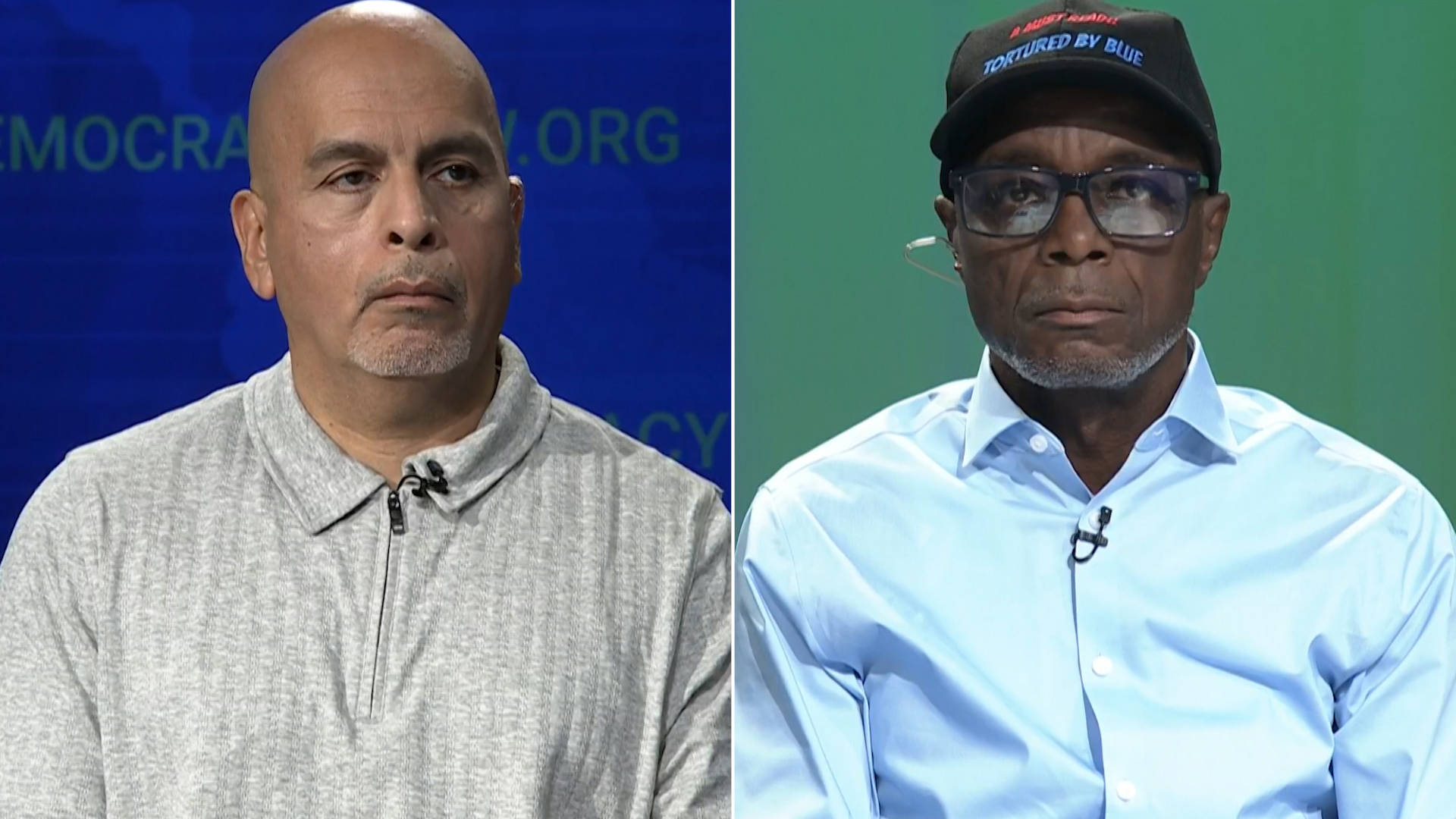This is a rush transcript. Copy may not be in its final form.
AMY GOODMAN: “All the King’s Horses,” Aretha Franklin, here on Democracy Now!, democracynow.org, “War, Peace and the Presidency: Breaking with Convention.” I’m Amy Goodman, with Juan González, as we broadcast from here in Chicago at CAN TV.
JUAN GONZÁLEZ: Well, we look now at how the city has a long history of police torture under police commander Jon Burge, who is accused of leading a torture ring that interrogated more than a hundred African American men in Chicago in the 1970s and 1980s. They routinely used electric shock and suffocation with plastic bags and typewriter covers, among other methods, to extract confessions from men who were later shown to be innocent. This comes as Illinois has one of the highest rates of wrongful convictions in the United States, and a disproportionate number of the wrongly convicted are Black or Brown people.
AMY GOODMAN: For more, we’re joined by two men from right here in Chicago who were exonerated after serving decades in prison.
Stanley Howard spent 16 years of his life on death row for a 1984 murder that evidence would later show he did not commit. He says he was tortured until he confessed to the crime. He’s the co-founder of the Death Row 10, a group of Black men on Illinois’s death row who were tortured by the notorious Chicago police commander Jon Burge and his detectives. Howard was pardoned by Governor George Ryan in 2003. He co-authored the book Tortured by Blue: The Chicago Police Torture Story.
We’re also joined by Jimmy Soto, who was released from an Illinois prison just this past December 14th, after a 42-year fight to prove his innocence. At the time of his release, Jimmy Soto was the longest-serving exonerated prisoner in Illinois history. Now he’s working on getting a law degree to help others like him.
We welcome you both to Democracy Now! It’s an honor to have you with us, as you both actually just recently got out. I don’t know if people remember what happened in the exposé, and he even went to court and was convicted of perjury, lying about the cover-up of torture of Black men in Chicago, Jon Burge. But you were one of those victims. If you can talk about what happened to you and what it meant to serve more than 40 years [sic] in prison, Stanley Howard?
STANLEY HOWARD: Well, what happened to me was a crime. I was tortured on November the 1st, November the 2nd of 1984. What I mean by “torture,” I was handcuffed with my hands behind my back, and that set of cuffs was cuffed to a ring on the wall. And these three detectives literally beat the heck out of me. When I refused to sign a confession to a crime I did not commit, they suffocated me with a plastic bag, and later a typewriter cover. I thought these three white detectives were actually trying to kill me. Mind you, I was 21 years old. Scared half to death and in fear of losing my life inside this interview room at 3:30, 4:00 in the morning, I actually agreed to sign a confession to a crime I did not commit.
I later discovered, when evidence started coming out, that I was not the only one. And at that time, I was assured that justice was going to prevail. I did not know that all three branches of government was either complicit in this scandal or worked to cover it up or just simply turned a blind eye to what was going on, maybe because they didn’t care. As long as they was obtaining convictions, that’s all it was about.
I end up on death row. And the courts kept seeing cases after cases after cases of these same officers’ names and the same techniques, but they kept denying all of the appeals. So, I wanted to take the argument from behind the closed doors of death row, and I wanted to take it to the streets. I wanted the people. If the people was willing to hear our stories and allow the state of Illinois to execute us, so be it. So I started the Death Row 10. And that campaign, we reached out to the Campaign to End the Death Penalty, and they helped us facilitate a public fight, if you will. And based on that, we started getting more movement, more movement, especially with Anthony Porter, who was released from death row after spending years and years on death row and was 30-some hours away from being executed. This is the time that we started the Death Row 10, along with the time that LaTanya Haggerty, a young girl that was killed by Chicago police because she had a cellphone in her hands.
JUAN GONZÁLEZ: And you, actually, while the time you were in prison, you became a jailhouse lawyer, helping so many other inmates. Can you talk about the experiences that you had there, helping to mount the legal arguments and the basis for yourself and others eventually being freed?
STANLEY HOWARD: Well, I had the experience of working with my appellate lawyer, who was horrible, so I started studying criminal law myself. I didn’t get any formal education, but I trained, and I studied, and I studied, and I studied. And I got to the point to where I wanted to have a say in my life, my appeals. And I believe I got to the point to where I wanted to help other guys on death row also, which is why I started the law class, so-called law class.
And based on the law class, we was able to get together, formulate arguments, organize, and push our fight, not just for the Death Row 10, but to counter the claims of the death penalty here in Illinois. At one point, we had 12, 13 guys executed, but we had 12, 13 guys released from death row. So, that tells you something is wrong. And through my advocacy, it wasn’t just simply about me. I wanted to help the other guys that I was there with, to help save their lives also, because I believe a government like this government should not be in the business of executing people, under any circumstances.
AMY GOODMAN: You were on death row for how many years?
STANLEY HOWARD: Sixteen years.
AMY GOODMAN: Sixteen years.
STANLEY HOWARD: Locked inside of a cell 23, 24 hours a day, every day, tortured. So, I was tortured by cops. Then I was tortured by the state of Illinois.
AMY GOODMAN: And now you’re free. Former Republican Governor George Ryan, governor of Illinois, commuted 167 prisoners on death row to life in prison. And then you have, before that, the — after that, in 2011, Democratic Governor Pat Quinn signed legislation that made Illinois the 16th state to abolish the death penalty. Jimmy Soto, I want to turn to you. Congratulations on being out, but the horror that you were in for over 40 years, the longest-held prisoner — exonerated prisoner in this country. Tell us your story.
JIMMY SOTO: Well, you know, it happened in 1981 on the Southwest Side of Chicago in an area called Little Village. A tragic shooting occurred. And I gave it no thought that it would ever come on my doorstep. Unfortunately, the police, as Stanley was pointing out, in that time period, used tactics in which they wanted to just close the case. And so, being pressured by those in authority in the city of Chicago, they set out to try to just solve the case in a way that skirted any legal methods that they should have done. They rounded up approximately 25 people from that area, 20 of which were under the age of 17. So, just think of that. These are juveniles. Held them for three days and got them to make false statements on me. They took them to the grand jury, and, yeah, they put the case on me. There was no evidence, physical, forensic, no eyewitnesses. They managed to get one individual to stand up and be, what they say, quote-unquote, an “accomplice witness.”
And at years of fighting, like Stanley, I was self-taught prison litigator. Over the course of that time, I managed to get two people fully exonerated. And I was able to get over 300 sentence reductions and 14 new trials. But, you know, the actual fight was to get me out. And eventually that happened. It wasn’t easy. It wasn’t an easy task. And I never want to see anybody go through that.
Unfortunately, like as you indicated, Juan, at the beginning of the show, that Illinois has some of the highest numbers of exonerations. I went to an exoneration conference in Louisiana shortly after I was released. And by far, Illinois, in just a year, one year, exceeded any other state for exonerations. And when I looked at the whole room and seen those thousands of people that have been exonerated over the years, it’s a clear red flag that there’s something seriously wrong with our criminal justice system.
JUAN GONZÁLEZ: And also, Illinois is a state that does not have parole for folks who are in prison. Can you talk about that and what that does —
JIMMY SOTO: Yeah.
JUAN GONZÁLEZ: — in terms of people staying in longer?
JIMMY SOTO: Yes, yes. I was sentenced to natural life without parole, which is a slow death by incarceration. And during that time in there, we started — I was going to school. I went to the Northwestern Prison Education Program, but I also joined PNAP, the Prison Neighborhood Arts Project. And there, there was a think tank. And in that think tank, individuals said, “Hey, there is no parole in Illinois. We need to do something about it.” And right there, there was an effort birthed, which we wanted to have, ParoleIllinois.org. And we formed a nonprofit organization to bring back parole. There’s been no parole in Illinois since 1978. And there’s a lot of people who have, quote-unquote, “been rehabilitated,” yet they linger for decades in the most horrible conditions. Because it’s not only the fact that I did 42 years, two months, two days; it’s the conditions in which I did it. As Stanley indicated, it is really slow torture every day.
JUAN GONZÁLEZ: And you mentioned also, in the discussions we had yesterday, that you also were organizing within the prison in terms of the Latino prisoners. For a while you spent time with some of the FALN pro-independence folks that were in prison, as well?
JIMMY SOTO: That’s correct. You know, Luis Rosa, in particular. As I said, there was programs giving you higher education, but they had nothing to show to give us an education about our history, Latinos. And so, we decided to formulate the Latino Cultural Exchange Committee, which was an independent program, which we now started to bring in the history of Puerto Rico, Mexico, Central America, South America, and bringing it to those and to awaken within them some dignity and some pride in their heritage.
AMY GOODMAN: Can you talk about the case of 51-year-old Michael Broadway, who died just this past June in Stateville prison? Just the year before, he was one of your classmates who were among the first group of incarcerated men to receive a bachelor’s degree from a top 10 university, Northwestern?
JIMMY SOTO: Yeah. Well, Michael was not only a cohort, but a friend. And when I learned about his death in June, it really hit me hard, because it shouldn’t have happened. The conditions there were [un]inhabitable. An independent engineering report, that the IDOC was aware of, said that six of the prisons in Illinois were not fit to have human beings in there. And so, Michael was in one of those prisons, Stateville. He was on one of the highest galleries, and it was very warm. It was hot. I was over 100 degrees, no circulation, windows sealed shut. Michael had an asthma attack and, unfortunately, died.
And when I learned that that happened, I held a town hall meeting here in Chicago. And there was — another organization was born. A movement was birthed in that. I said, “I’m going to do something about this and bring awareness of what’s going on.” And I called it Building Communities Not Prisons, to not let Michael’s death be in vain. And so, we pushed really hard to get Stateville closed. And I’m glad to say that, finally, a federal court judge ordered Stateville closed by September 30th.
But it doesn’t end there. The women in Logan are also subjected to horrible conditions. And we’re pushing to get that closed, and all of those prisons closed. The IDOC is operating at only 60%. That means they’ve got 40% room. But yet they want to knock down Stateville and Logan and rebuild a new prison at a cost of $900 million. And my question is: Why can’t we take that $900 million and put it at the front end to prevent people coming to prison, as opposed to investing in the future that we’re saying we’re going to continue this nightmare of mass incarceration?
JUAN GONZÁLEZ: And when you talk about conditions, could you talk about what those conditions are? Even the water supply in many of these prisons is toxic?
JIMMY SOTO: Yes, yes. It’s been really noted that they know, that these antiquated prisons, for one, the plumbing, the piping has got lead pipes, so that means the lead is going to be in the water. But even the sources, the sources like the aquifers that are there in Will County, in Joliet, the sources where they get the water that is ran to the prison, it also has heavy metals, other toxins which is in the water, which is causing it. I personally had my blood tested, and I had elevated levels of lead, caused by drinking that water in Stateville.
AMY GOODMAN: So, you’ve been invited to the Democratic National Convention Tuesday night?
JIMMY SOTO: Yes, by a group called FWD.us. And I’m going to go there and meet some people. And they are a group who wants to show how immigration right now, which is a hot-topic issue, and carceral systems are intertwined, you know, because now they want to criminalize. They want to criminalize Black and Brown bodies. And this is a way to further criminalize through saying these migrants that are coming in are, quote-unquote, “bad hombres,” bad people.
JUAN GONZÁLEZ: And, Stanley, I wanted to ask you — the Democratic National Convention is about to nominate a former prosecutor, Kamala Harris, as the Democratic candidate for president. Your sense of the continued emphasis, even among the Democrats, on punishment and incarceration as a means of dealing with crime?
STANLEY HOWARD: Well, I’d like to also say that the mental health service inside the prison is terrible. The healthcare is terrible. And all the buildings are crazy. I did a protest out in front of Cook County Jail a couple of weeks ago. And I looked at this building, where the prosecutor’s office was at. Mind you, when you say that Cook County is the wrongful conviction capital of the world, somebody had to be involved in that. It was the prosecutors. They all got away with it, and still getting away with it.
Kamala Harris, I do not know much about her history as a prosecutor, but knowing that there is a prosecutor at the helm of our government, and she is going to reach back and tell these prosecutors their number one job is to seek justice and not convictions, I don’t know about that. I have many questions for her about her life as a prosecutor.
But I also would like to know what she’s going to do to reform this system. From the time when they used to call, quote-unquote, the “war on drugs,” the “war on crime,” and this “get tough on crime,” to where, as we know, the crime has continued to falling, and all these dramatic rulings and bills that they put in place, what about rolling those back now? What is she going to do for that effort?
And that’s why I’m here now. Since I’ve been out, I’m working at Uptown People’s Law Center, who does great work for those on the inside. And I receive telephone calls from family members. I answer the guys on the inside’s mail also. And to know that prosecutors are at the helm of this mass incarceration — Jimmy said there was thousands of people that was wrongly convicted at this convention that he was at. Prosecutors prosecuted their cases. And like I said in my book, Tortured by Blue, the problem with prosecutors is that it takes a prosecutor to prosecute a prosecutor, but prosecutors are not in the business of prosecuting prosecutors.
AMY GOODMAN: Twenty-four states allow the death penalty. Twenty-three states have abolished capital punishment altogether. Three states — California, Oregon and Pennsylvania — have governor-issued moratoriums in place halting executions in the state. We’re almost at the point where more than half of the states in this country will have abolished the death penalty. And then the argument will be, overall, in terms of getting rid of it, that it is cruel and unusual punishment. The U.S. is very rare in the industrialized world in continuing with the death penalty. Your thoughts on this, Stanley, as a man who might have been executed, if it weren’t for your activism and your community that fought for you until ultimately you were exonerated?
STANLEY HOWARD: Well, it’s kind of ironic that the conservative party is for life on the front end, but they are for death on the back end. I do not understand that philosophy. But we have a guy by the name of Murray Hooper, who was transferred from Illinois’s death row to Arizona. It’s amazing that half of Arizonans do not trust their government, so much so they don’t even trust the election. But he was executed last year. So, the government is in the business of executing people but can’t get their elections right. I believe that a country that executes its citizens really do not have the moral compass to tell another country nowhere around this planet what to do. It was once said that if you wanted to know what is going on in a country, all you had to do is look inside the prisons and look inside of the death row. And we have to end this death penalty in this country, and we have to end life without the possibility of parole also.
AMY GOODMAN: Well, I want to thank you both for being with us. It has been so important. Do you think, when it comes to the Democratic and Republican leaders of this country, that it makes a difference who is in power? I’ll end with you, Jimmy.
JIMMY SOTO: Absolutely, it does. I mean, we have to get a Democrat in there. Kamala may not be the best candidate, but we need to get out there and vote, because the only other alternative is Trump. And I think Trump will turn this country upside down to where we’re going to probably go back 10, 15 years of progress that we’ve made, not only economically, but even within our carceral system. There needs to be a change. There needs to be a change now.
AMY GOODMAN: Well, I want to thank both of you again. Jimmy Soto, longest-serving exonerated prisoner in Illinois history. Since his release in December, he’s been working on going to law school, getting a law degree to help others like him. And Stanley Howard, co-founder of Death Row 10, spent 16 years of his life on death row for a 1984 murder that evidence would later show he did not commit.











Post comments (0)